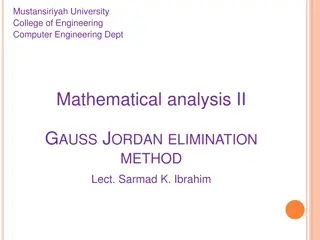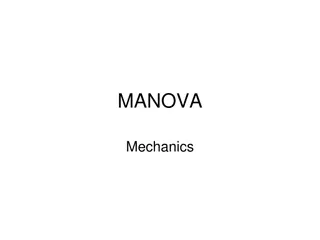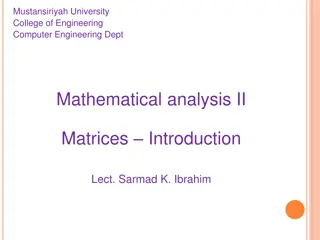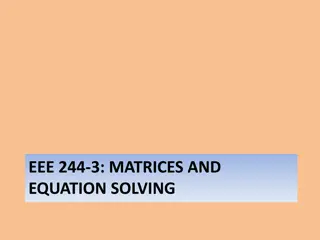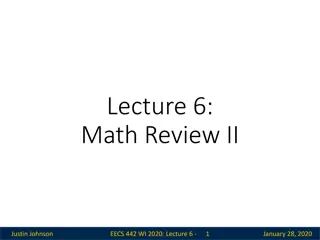Understanding Matrices: Types, Definitions, and Operations
Matrices are ordered arrays used to express linear equations. Learn about types, definition, equality, and operations like addition, subtraction, and multiplication. Discover matrix equality and the transpose of a matrix, including symmetric and skew-symmetric matrices.
Download Presentation

Please find below an Image/Link to download the presentation.
The content on the website is provided AS IS for your information and personal use only. It may not be sold, licensed, or shared on other websites without obtaining consent from the author. Download presentation by click this link. If you encounter any issues during the download, it is possible that the publisher has removed the file from their server.
E N D
Presentation Transcript
TYPES OF MATRICES (UNIT 1)
DEFINITION OF MATRIX Matrices Definition Matrices are the ordered rectangular array of numbers, which are used to express linear equations. A matrix has rows and columns. we can also perform the mathematical operations on matrices such as addition, subtraction, multiplication of matrix. Suppose the number of rows is m and columns is n, then the matrix is represented as m n matrix.
EQUALITY OF MATRICES Equality of matrices is a concept when two or more matrices are equal. Matrices are said to be equal if they have the same number of rows, the same number of columns and their corresponding elements are equal. Equality of matrices does not hold of either of the mentioned properties does not hold. This implies if the order of the matrices is not equal or at least one pair of the corresponding elements is not equal, then the two matrices are said to be unequal.
DEFINITION OF EQUALITY OF MATRICES Two matrices A = [aij] and B = [bij] are said to be equal if and only if A and B have the same order, i.e., A and B have the same number of rows and the same number of columns, and corresponding elements of A and B are equal, i.e., aij= bijfor all i and j. The above statement is the main definition for the equality of matrices. Matrix Equality does not hold if either of the above-mentioned properties is not true for the matrices A and B. In this case, matrices A and B are said to be unequal.
TRANSPOSE OF A MATRIX The transpose of a matrix is found by interchanging its rows into columns or columns into rows. The transpose of the matrix is denoted by using the letter T in the superscript of the given matrix. For example, if A is the given matrix, then the transpose of the matrix is represented by A or AT. The following statement generalizes the matrix transpose: If = , then = . Thus Transpose of a Matrix is defined as A Matrix which is formed by turning all the rows of a given matrix into columns and vice-versa.
SYMMETRIC AND SKEW SYMMETRIC MATRICES To understand if a matrix is a symmetric matrix, it is very important to know about transpose of a matrix and how to find it. If we interchange rows and columns of an m n matrix to get an n m matrix, the new matrix is called the transpose of the given matrix. There are two possibilities for the number of rows (m) and columns (n) of a given matrix: If m = n, the matrix is square If m n, the matrix is rectangular
For the second case, the transpose of a matrix can never be equal to it. This is because, for equality, the order of the matrices should be the same. Hence, the only case where the transpose of a matrix can be equal to it, is when the matrix is square. But this is only the first condition. Even if the matrix is square, its transpose may or may not be equal to it.
SKEW HERMITION MATRIX A skew-Hermitian matrix is the anti of a Hermitian matrix which is why the skew- Hermitian matrix is also known as the anti-Hermitian matrix. The skew-Hermitian matrix is closely similar to that of a skew-symmetric matrix. A skew-symmetric matrix is equal to the negative of its transpose; similarly, a skew-Hermitian matrix is equal to the negative of its conjugate transpose. Thus, a skew-Hermitian matrix satisfies the properties opposite to that of a Hermitian matrix, which was named after a French mathematician Charles Hermite. He came across the concept of these types of matrices while studying for the matrix, which always has real eigenvalues.
WHAT IS A SKEW HERMITION MATRIX? A square matrix of complex numbers is said to be a skew-Hermitian matrix if that matrix is equal to the negative of its conjugate transpose, also called tranjugate. Mathematically, the definition of the skew- Hermitian matrix is as follows: A square matrix A = [aij]n n is such that A* = A, that is, for every aij A, (1 i, j n), then A is called a skew-Hermitian matrix. Where conjugate transpose of A. Thus,A = [aij]n n is a skew-Hermitian matrix A* = A
A unitary matrix is a square matrix of complex numbers, whose inverse is equal to its conjugate transpose. Alternatively, the product of the unitary matrix and the conjugate transpose of a unitary matrix is equal to the identity matrix. i.e., if U is a unitary matrix and UHis its complex transpose (which is sometimes denoted as U*) then one /both of the following conditions is satisfied. UNITARY MATRIX UH= U-1 UHU = U UH= I where I is the identity matrix whose order is the same as U.
The matrix is said to be an orthogonal matrix if the product of a matrix and its transpose gives an identity value. Before discussing it briefly, let us first know what matrices are. A matrix is a rectangular array of numbers which are arranged in rows and columns. ORTHOGONAL MATRIX







